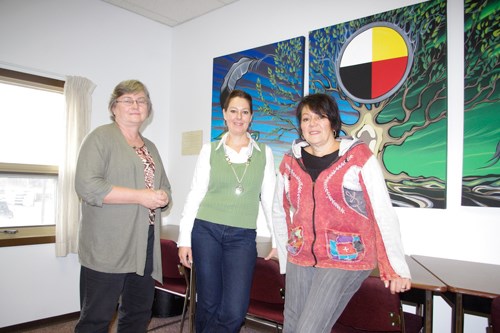In big cities, the sex trade is obvious, for participants and observers, with prostitutes negotiating with their customers in public or advertising their services under the guise of an escort service, either in print publications or online.
Elsewhere, it isn't as plain to see.
"One thing we have discovered over the years is that our kids in the North, you don't see people standing on street corners here," says Sharon Kent, district counsellor with the School District of Mystery Lake and the chair of Thompson's Sexual Exploitation Awareness Team (SEAT). "Our youth think, 'Oh, he's going to buy me a pizza, oh, I get free cab rides, oh my God, I got a new cell phone, I got a new hoodie,' right?"
"It's a trade," says Lori Oberdorfer, an instructor and student counsellor with the University of Manitoba's Northern Social Work program in Thompson, and the principal investigator of an exploratory study into sexual exploitation among female youth in Northern Manitoba.
Defined as the act of coercing, luring or engaging someone into a sexual act, the sex trade or pornography in exchange for money, drugs, shelter, food or other necessities, sexual exploitation can take place almost anywhere, says Kent.
"The invisible sex trade can take place in hidden venues such as private homes, party houses, drug houses located throughout the province of Manitoba," Kent says, and often involves victims who are still minors, starting when they are as young as 12 or 13 years old, on average. "It is estimated that hundreds of children are victimized in the invisible sex trade."
But people, often including the victims, are unaware that this behaviour is happening or that it's wrong.
"Our northern regional team is looking at trying to provide awareness to the public and that in terms of the fact that this issue is occurring," says Oberdorfer.
In many cases, says Kent, the victims of sexual exploitation have been brought up with it and therefore think it's normal.
"They don't have a strong point of reference and they don't know," she says. "This is just something that has been done to them so it continues. When you don't know any different than where do you get your point of reference?"
What's more, families and the larger community may ignore the issue in hopes of protecting themselves from the spotlight.
"A few years back, we had a grandfather impregnate his 12-year-old granddaughter and she got removed from the community but not him," Kent says.
Part of the reason for the lack or personal or public awareness stems from the fact that the perpetrators of sexual exploitation select victims carefully and frame the relationship so that it isn't obvious what their true motives are.
"They know how to groom, they know how to pick," Kent says. "They're not going to target a person that is boisterous and bouncing around. If you take five people in a family and you've got one that's a little overweight, more quiet, that's not so outspoken, that's just kind of, you know, more vulnerable, that's who a predator will go after. They won't go after someone who is rambunctious and out and about and in and out and all that stuff because those are the ones that won't keep quiet."
Conditions in Thompson are ripe for sexual exploitation because there is a large population of people, both youth and adults, who aren't connected to the community in a meaningful way, says Oberdorfer.
"We have a lot of contract workers, people not necessarily long-term in the community that might have commitments or whatever," she says.
"They come in from Wuskwatim, they're here for a week, they party hearty, go back, they work for 40 days," adds K ent.
Conversely, many victims are also detached from their support systems.
"We have a lot of kids that are placed here in Thompson that come from outlying communities," Kent says. "They have no connection to family, they have no connection whether they're in care or they've come as external students. They have no sense of belonging so anybody that can show them some kindness, can show them something, they go, 'Oh, OK.'"
"That's kind of how they get sucked into the whole thing," says Oberdorfer.
Nonetheless, sexual exploitation does not always involve strangers or people from a particular subset of the population, though, given Northern Manitoba's demographics, a high proportion of those involved, are aboriginal.
"It doesn't matter what income level, what ethnic background," says Oberdorfer. "People are getting exploited."
And while sexual exploitation often involves an age gap, that isn't necessarily the case.
"We have young boys that exploit the girls," says Kent. "You come to our party and we'll give you free drugs and you can do a rainbow or you can, you know, engage in whatever. We'll like you."
[A "rainbow party" is when a group of women wearing different-coloured lipsticks perform oral sex on a group of men, leaving a rainbow pattern on the men's genitals. According to Wikipedia, the term came to prominence after being featured on a 2003 episode of the Oprah Winfrey Show, though Dr. Deborah Tolman, director of the Center for Research on Gender and Sexuality at San Francisco State University, told the New York Times in 2005 that the phenomenon "has all the classic hallmarks of a moral panic" and was probably more prevalent in legend than in reality.]
In such cases, Kent says the girls should analyze the nature of the relationship more closely.
"I say to those young girl, would they take you home for Sunday dinner? Would they take you home to their parents?"
"You always have to be wary," says Oberdorfer. As is the case with sexual abuse, victims often know the perpetrator in another context.
"They're not these strange men all the time that come into the community," says Lynda Paziuk, also an instructor in the Northern Social Work program and one of Oberdorfer's co-investigators on the sexual exploitation study.
"Remember that these are somebody's daughter, somebody's granddaughters, somebody's niece, someone's mother, someone's grandchild, right?" says Kent. "And some of the perpetrators are someone's father, someone's grandfather, someone's uncle."
One of the dangers of being sexually exploited is that it can lead victims into the sex trade where they may be at risk of violence.
"You get into the drugs and the alcohol abuse and then you get into the gangs because of the predators," says Kent. "'This is for free. We'll give you some drugs. We'll give you some alcohol.' Right, and then you go, 'Oh, no, you have to start to pay for this. You need to be out on the street.'"
"Now you owe me," says Oberdorfer.
These women may end up being trafficked, says Kent, and put to work as prostitutes anywhere in Canada.
"We have people from Manitoba that could be in Calgary, Edmonton, Fort McMurray, where they're going to make some money there for their pimps," says Kent, noting that it's the women who usually bear the brunt of the consequences. "It's not the pimps that are getting charged, you know, very seldom do you hear of a pimp getting charged. It's the girls. The girls get arrested for soliciting sex."
Education, like that provided by SEAT, which arranges presentations for youth and other groups, is key to reducing sexual exploitation, says Kent, by helping those who are in such a situation face up to reality.
"If I'm standing up front doing a presentation you can actually see certain people go, 'Oh my God, that's going on,' and then you'll see them kind of slouch down," says Kent. "They don't know they've been exploited."
"It's just a survival tactic," says Paziuk.
That's why the work being done by SEAT to increase awareness is important.
"A huge thrust of our northern team is just educating and starting to kind of talk about the issue in a hopefully non-threatening way with the purpose of just letting people know what's acceptable, what's right, what's wrong, what occurring, where you can go, what you can do," Oberdorfer says. "A lot of people don't have anybody to talk to."
And although a great deal of sexual exploitation is hidden, a significant percentage goes on right in front of people's noses because they don't recognize that that's what it is. It may look like - and be - consenting behaviour between two adults, but just because it isn't illegal doesn't make it OK.
"There's certain guys in this town that do nothing but cruise when the bars are being let out, because they prey on drunken aboriginal women," says Kent. "Condoms are found and underwear are found and alcohol bottles are found on all our school properties."
"It's not innocent teenagers having a love affair or anything like that, this is serious exploitation here without even the knowledge that this is happening," says Paziuk.
Hotel associations have codes of conduct, says Kent, but not all establishments in Thompson follow them. "We need to go in there and do another presentation. To bring awareness to the front desk workers, to the bartenders, to the vendors, saying that is you see this, this is what it is that you're looking at. Why is a drunken older man taking advantage of an underage woman?"
Ultimately, though, responsibility rests with those initiating exploitative behaviour.
"In a lot of ways, we've laid the responsibility on the victim but we need to switch that to you know what, it's the offender," Oberdorfer says. "The whole issue comes down to supply and demand. As long as the demand is there, as long as there's sick people who will take advantage of other people's misfortune and whatnot, somehow society has to supply and that's the cycle of it."
Paziuk says that sexual exploitation doesn't affect everyone directly, but its consequences probably do.
"What is the point of caring about this?" she says. "The big picture is that this is exploitive, which is unhealthy, so the person becomes unhealthy so the society becomes unhealthy so you can see this unhealthiness by addictions, for example, the selling of the booze, the selling of the drugs. That's unhealthy, right? It's all interconnected."




